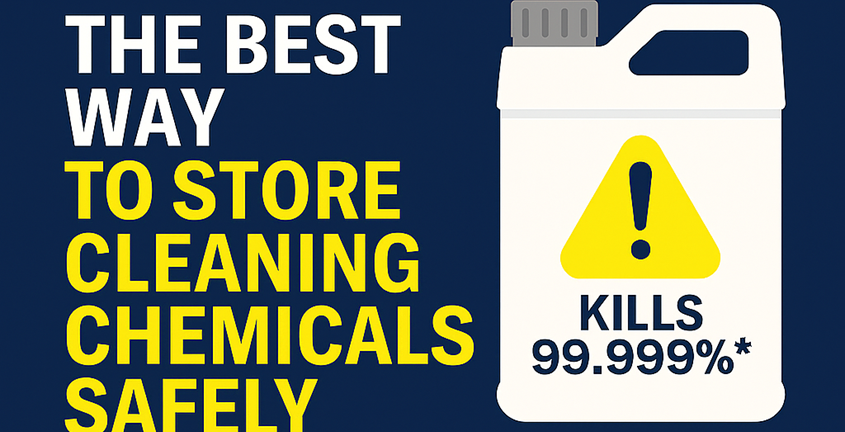Storing Chemicals: What You Need to Know!

The Best Way to Store Cleaning Chemicals Safely
Whether you’re running a care home, managing a commercial kitchen, or stocking janitorial supplies for a school, proper chemical storage isn’t just good practice - it’s a legal and safety requirement. Mishandling cleaning chemicals can lead to leaks, dangerous reactions, or even health hazards for your staff.
Let’s break down the best practices for storing cleaning chemicals safely, with a focus on temperature, segregation, and labelling - the three pillars of chemical safety.
🌡️ Temperature Control: Why It Matters
Many cleaning chemicals are sensitive to heat, cold, and humidity. Improper storage can degrade their effectiveness or trigger dangerous reactions.
✅ Best Practices:
-
Store below 25°C unless otherwise stated on the label or SDS.
-
Avoid freezing temperatures - some products separate or lose potency when frozen.
-
Keep away from direct sunlight - UV exposure can break down active ingredients.
-
Use climate-controlled storage if your facility experiences temperature extremes.
🧪 Real-World Example:
A bleach-based disinfectant stored in a hot storeroom may release chlorine gas or lose its sanitising power. Always check the Safety Data Sheet (SDS) for temperature guidelines.
🚫 Segregation: Preventing Dangerous Reactions
Not all chemicals play nicely together. Mixing incompatible substances - even accidentally - can cause fires, toxic fumes, or corrosive spills.
✅ Best Practices:
-
Separate acids from alkalis - mixing them can cause violent reactions.
-
Keep oxidisers away from flammables - this includes bleach and alcohol-based products.
-
Use dedicated shelving or cabinets for different hazard classes.
-
Label shelves clearly to prevent cross-contamination.
🔥 Real-World Example:
Storing bleach next to an acidic descaler can result in the release of toxic chlorine gas if they leak or spill. Segregation is your first line of defence.
🏷️ Labelling: Clarity Saves Lives
Clear labelling ensures that staff know what they’re handling - and how to handle it safely.
✅ Best Practices:
-
Use original containers whenever possible. Never decant into unlabelled bottles.
-
Ensure hazard symbols are visible - flammable, corrosive, toxic, etc.
-
Include dilution instructions if decanting is necessary.
-
Use waterproof, chemical-resistant labels that won’t fade or peel.
📋 Real-World Example:
A bottle marked “Cleaner” tells you nothing. A properly labelled bottle should say “QuatClean Pro - Disinfectant - Dilute 1:10 - BS EN 1276 Compliant - Store Below 25°C.”
🧤 Bonus Tips for Bulk Buyers
-
Create a COSHH folder with SDSs for every product.
-
Train staff on storage protocols and emergency procedures.
-
Audit your storeroom quarterly to check for expired or damaged containers.
-
Use spill kits and PPE near storage areas.
✅ Astral Hygiene Tip
We supply SDSs and storage guidance for every product we sell - and we’re happy to help you set up a compliant, safe chemical storage system. Whether you’re buying a single bottle or a full pallet, we’ve got your back.








